 Leading Blog | Posts by Month |
 Leading Blog | Posts by Month |
06.30.21

LeadershipNow 140: June 2021 Compilation
See more on
Posted by Michael McKinney at 07:45 AM
06.28.21

Be Where Your Feet Are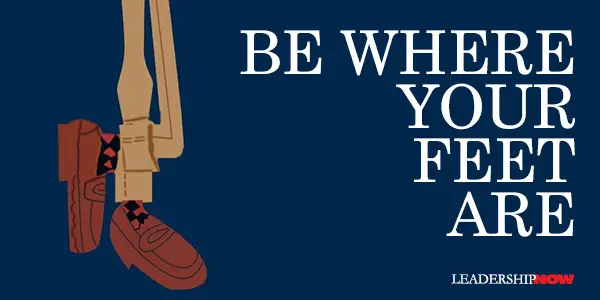
TOO OFTEN we are busy looking for the next thing. The problem is our experiences tend to be shallow. We miss out on the richness of being in the moment. To counteract this, we try to find balance. But balance doesn’t create greatness. The solution is not balance, says sports executive Scott O’Neil in Be Where Your Feet Are. The answer is to make “the most of each moment and ridding ourselves of the toxic habit of constantly looking forward to the next thing.” Finding balance is “like aspiring to be in the middle.” On the other hand, “being present, focused, committed, and hardworking at home and at work is the path to finding success and fulfillment.” To that end, O’Neil offers, through the use of stories both personal and from scores of others, seven principles to keep you present, grounded and thriving. The stories and the grounding principle he draws from them really make each of these seven principles come to life. I offer one of the insights from each. #1 Be Where Your Feet Are With so many distractions, it is harder today than ever to be where your feet are. It has also never been more important. To be more present, O’Neil offers a four-part process:
#2 Change The Race In those times when we feel stuck, unable to get out of the funk we are in, we need to change the race:
The most critical things to keep in mind include knowing when you need to change the race you are running and not shutting down—remember that isolation is your kryptonite when things are going badly. Engage people in your life and do not let ego or pride get it the way of good decision-making or getting help. #3 WMI – What’s Most Important The world is filled with universe moments, which is when things happen for a reason and people, places, and events seemingly drop into your life with purpose. #4 Fail Forward Failure is a better teacher than success. Failure is a more effective teacher than success. It’s rarely enjoyable, but it is critically important to be a student of life. #5 Be The Purple Water Buffalo Be an extraordinary teammate. Hold the team above self. #6 Assume Positive Intent What if you assumed positive intent from those with whom you connect, no matter how many alternative and less generous assumptions were possible? #7 Trust The Process In a world dominated by instant gratification and obsessed by the spotlight of now, Trust the Process is the commitment that you will keep the long-term view at the forefront of your planning and decision-making. Trust the Process is about understanding the mistakes and taking the time to revisit what went wrong and why, and then leverage that information to get smarter and make better decisions in the future. 
Posted by Michael McKinney at 06:37 AM
06.25.21

Need More Fun at Work? 5 Do’s and 5 Don’ts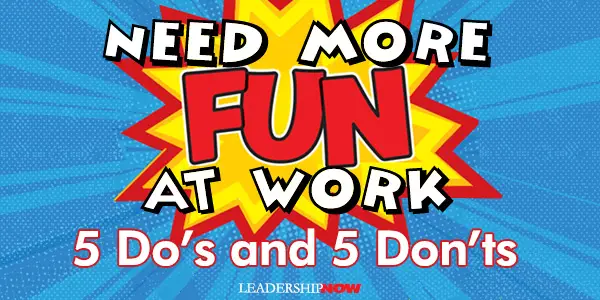
THERE’S much more to workplace fun than having a Ping-Pong table in the employee break room, free soda in the refrigerator, and an occasional office party. Prioritizing fun at work is really about embedding fun into the work culture. According to the employees who work for firms listed in Fortune’s “100 Best Companies to Work for in America,” the most defining characteristic of these organizations is they’re all “fun” places to work. Yet, there’s effort involved in making work fun, and it’s important to be intentional when crafting and tailoring fun to your employees’ desires! Here are some “do’s” and “don’ts” to help guide you in navigating workplace fun: Do’s Happy employees make for more productive employees. The University of Warwick conducted a study of more than 700 participants and concluded that increased happiness led to a 12% spike in productivity. And, according to research by Ben Waber, companies can increase productivity by up to 25% by making small changes that increase employees’ sense of fun and satisfaction. Take note of these “do’s” as you strive to implement a fun workplace culture:
Dont’s What’s fun to some may not be fun to others, so you need to get to know the people you work with and allow them the freedom and flexibility to have fun in ways they appreciate. Take note of these “don’ts” as you strive to implement a fun workplace culture:
Takeaways
 
Posted by Michael McKinney at 07:26 AM
06.24.21

Leading Thoughts for June 24, 2021
IDEAS shared have the power to expand perspectives, change thinking, and move lives. Here are two ideas for the curious mind to engage with: Ron Friedman on how experience begets automaticity and automaticity stifles learning. And the need for the right kind of practice to improve and grow: “Working on our weaknesses is unpleasant, stressful, and hard. But it’s a process that does something crucial for skill development: it breaks the spell of automaticity. Source: Decoding Greatness: How the Best in the World Reverse Engineer Success Former Navy Seal Brent Gleeson on the difference between planning and preparation: “Planning is certainly part of preparation, but it’s much more than that. Preparation means you know the plan, but you also have the functionality and skill to pivot when things don’t go according to that plan. Source: TakingPoint: A Navy SEAL’s 10 Fail Safe Principles for Leading Through Change Look for these ideas every Thursday on the Leading Blog. Find more ideas on the LeadingThoughts index.
Posted by Michael McKinney at 01:46 PM
06.21.21

What Your Organization Really Needs from You: Influence and Impact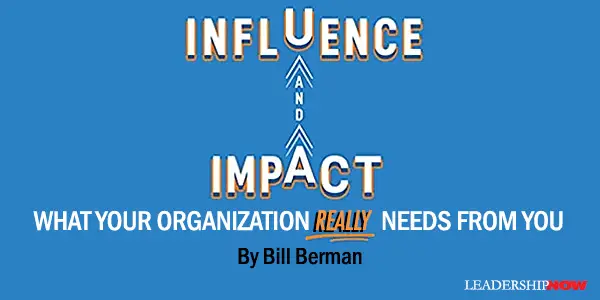
LEADERS in today’s multinational, matrixed, diverse business world have impact through their ability to influence others. In many organizations, authority-based leadership is waning. Success is all about getting others to care about what you care about. The most effective leaders get their teams, their colleagues, and their suppliers to emphasize their priorities. People listen to what you have to say, and follow you, because they want to, not because they have to. When you have that kind of influence with others, the results begin to speak for themselves. In other words, you have impact on the organization. Why do some leaders “have a seat at the table,” and some feel they are struggling to bring others along? Why are some leaders able to influence in one role, but in another role, discover they aren’t having the influence they should? The solution is far from magical. For a large majority of leaders, the struggle to have influence and impact comes from things that you can manage and change. If you approach this situation with a growth mindset, you can build or rebuild that influence. In my new book, Influence and Impact: Discover and Excel at What Your Organization Needs From You The Most, written with George Bradt, we provide the tools every leader needs to grow and develop into the leader that others want to follow. Through my work with business leaders from CEOs to first-line managers, it has become clear that many people with strong technical prowess and powerful business acumen have unintentionally misunderstood an unwritten but essential aspect of their job. When organizations send clients to me for executive coaching, the work usually focuses on one of two things: How the leader thinks about their job, and how they do that job. Put simply, many leaders are not focused on two essential elements of their job. First, they are not completely focused on the priorities their organization needs from them. They may be doing the job mostly right, or they may be doing what their job description says. But many times, they are focused partly on what they know, what they wish, or what is comfortable, rather than what is needed. Tommy had risen to become the leader of a 1500-person business unit spanning four continents. He knew the economics of his business and was able convert his skills into practical technology and process solutions. But like many people, his strengths were also his weaknesses. Because Tommy understood the business in such depth, he often knew the answers well before his team did. As a result, he would identify the solution, inform others, and tell them to execute. Tommy felt overworked and underappreciated. His team felt undervalued, under-challenged, and demoralized. Through the coaching work we did, Tommy realized that he was avoiding the more complex and ambiguous aspects of his work where he had less confidence. As a result, Tommy was able to step back and let his team sort out operational problems without his involvement. Tommy’s boss saw that Tommy had freed up time and refocused his energies on what the manager needed from him, and told him, “I’ve been waiting for you to figure this out.” Second, leaders are doing the right things, but in a way that is not aligned with the style, attitudes and mores of their organization; in other words, the organizational culture. For example, they are decisive when they need to be collaborative. They are direct and blunt when they need to be tactful and patient. Or, they push for autonomy when their manager wants engagement. These are just a few examples. Fortunately, leaders can enhance their influence and impact by identifying and consistently focusing on the mission critical parts of their role and the essential aspects of the culture. The steps to building your influence are clear:
Every leader can identify the parts of their role that meet the needs of their manager, their colleagues, and their business. Every leader can understand the culture, and decide if it is a fit for them, or if they can change a few aspects of their style to adapt. All it takes is a willingness to confront the reality of the situation and grow as a leader. This is the key to professional success in organizations: Doing the job that is needed by the organization, in the way that is needed by the culture, consistently and reliably. Developing a deliberate focus, delivered in a manner that is aligned with the style and manner of your organization, invariably results in increased influence with others, a willingness to follow, and a larger impact on the organization and its mission.  
Posted by Michael McKinney at 07:45 AM
06.18.21

Wellbeing at Work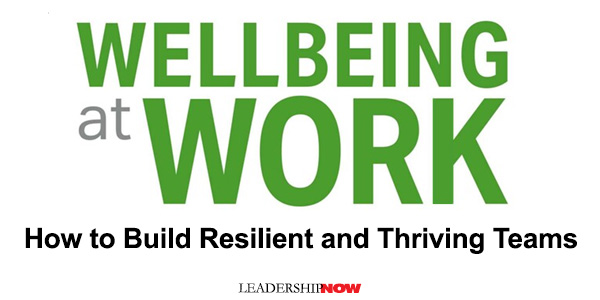
WHAT DOES it take to thrive? It seems to be an elusive goal. Gallup research has found that about seven in 10 people are struggling or suffering in their lives. In Wellbeing at Work, Jim Clifton and Jim Harter report that beginning in the late 1950s, Gallup sought to discover and quantify the difference between the best possible life and the worst possible life. Currently (2021), “Gallup has found that 17% of the world’s population is suffering (worst life), 59% is struggling, and 25% is thriving (best Life).” So, what does this mean to leaders? People bring the whole person to work. “Work should be a stabilizing force in people’s lives. And employers play a central role in shaping the whole person.” People who are not “thriving in their lives are much more vulnerable and add risk to your organization.” 61% higher likelihood of burnout often or always
If you follow this blog, it is obvious to you that this impacts relationship, creativity and innovation, energy, and trust. From the Gallup global surveys of wellbeing, there emerged five essential elements of wellbeing that differentiate a thriving life from a suffering or struggling life. These are all aspects of your life that you can do something about. Interestingly, Gallup found that the most important element is career wellbeing. Thriving is having a positive view of your life in each of these five areas. Career Wellbeing: You Like What You Do Every Day “My job and my manager are the two strongest links to net thriving.” Many find spending time with their manager to be the worst time of their day. We can fix that by improving employee experiences and teaching managers to be better coaches. What can leaders do?
Social Wellbeing: You Have Meaningful Friendships in Your Life Social time builds friendships. Friendships mitigate division, bias, gossip, and office politics. Gallup found that “almost all forms of social time boost mood, but technological remote forms such as texting and social media have thresholds—mood drops after moderate amounts. While both remote and in-person socializing is beneficial, in-person interaction has the greatest impact on mood. But that doesn’t mean you have to overdo it or that social connections have to drain time to be effective. Create regular opportunities for people to get to know one another through work.” Financial Wellbeing: You Manage Your Money Well Almost half of Americans live paycheck to paycheck. Money may not buy happiness but properly managed, it creates more opportunities and freedom. Raises in income affect happiness to a point. “Above an annual income of 90,000 on average, daily emotions do not improve with increases in income.” Leaders can help by providing financial planning, investing, and savings resources and tools. Physical Wellbeing: You Have Energy to Get Things Done “Your organization’s ability to bounce back from a public health crisis, or any crisis, depends on how resilient your employees are.” So, encouraging healthy choices is a win/win. We have the most control over sleep, exercise, and diet. All three can improve our immunity and mood. Community Wellbeing: You Like Where You Live Communities help people know that their lives matter outside of work too. “No matter how digital society has become, people still live in physical places that form the foundation of their social lives.” Not just being a part of something but caring for others fights against stress and negative emotions. Like the other four wellbeing elements, community wellbeing feeds, and is fed by, the other elements of wellbeing. Those with high community wellbeing have active lives, are more likely to be engaged at work, and have more frequent social interactions. In the same way, physical health and financial security make giving and volunteering possible. While career wellbeing is foundational to the other four elements, it is important that they are all in balance. “All things being equal, thriving in what you do every day makes for stronger relationships, a more secure financial life, good health, and greater community involvement.” If you are on the low end of the scale on any one or more of the elements, then that’s where you need to start to move toward thriving. The elements are all interrelated, so focusing on just one area will cause you to fail overall. “Those who had an imbalance in points across the elements had the lowest wellbeing—in particular when they gave an overabundance to financial wellbeing.” If you want to build a thriving culture, you need to avoid the four risks:
People need, especially in a crisis, four leadership traits as a signal that their life will be OK: Hope (Is there a clear plan for the future?), Stability (Am I well-prepared to do my work?), Trust (Does my manager keep me informed?), and Compassion (Does my organization care about my wellbeing?). These help to build a net thriving and resilient culture. The authors dig deeper into implementing wellbeing practices. As knowing your employee strengths “is the first step to having the most individualized, positive and effective wellbeing conversation with them,” they have included an appendix that ties in with the CliftonStrengths profiles. A very useful tool, along with the condensed action guide you will also find in the appendix. 
Posted by Michael McKinney at 08:24 AM
06.17.21

Leading Thoughts for June 17, 2021
IDEAS shared have the power to expand perspectives, change thinking, and move lives. Here are two ideas for the curious mind to engage with: Leadership coach Ruchira Chaudhary on the difference between mentors and coaches: “Mentors provide direction to their mentees, giving them the opportunity to become more like them. Coaches, though, don’t offer directions or even answers. A good coach instead helps the coachee come up with their own answers. As a coach and leader, you—unlike the mentor—do not provide advice from a distance. You are right there where all the action is taking place. You are observing, providing feedback, sometimes nuggets of wisdom and encouragement, sometimes nudging, sometimes directing, and often times proactively seeking them out to help them be a better version of themselves. You (ideally) lead these interactions—not your coachee. In essence, a mentor guides your (career of life) journey, whereas a coach guides your (current) practice.” Source: Coaching: The Secret Code to Uncommon Leadership Evolutionary biologist Rebecca Heiss on how our inter-gender instincts can influence our perceptions of leadership roles: “As soon as we are reminded that women, even powerful, responsible, qualified leaders, are mothers, our sex instinct fires up ancient associations that hold women back. But the flip side of gender bias must also be given due consideration. Look for these ideas every Thursday on the Leading Blog. Find more ideas on the LeadingThoughts index.
Posted by Michael McKinney at 08:09 AM
06.14.21

The Lost Art of Connecting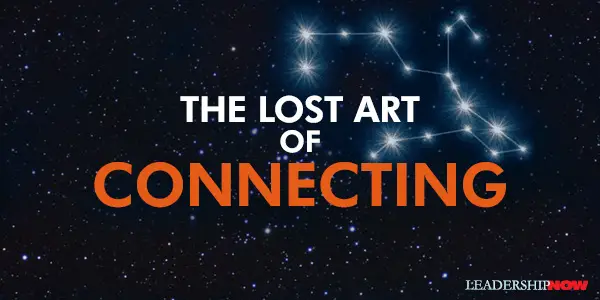
WHO are the stars in your constellation? What kind of constellation do you want to create? Connection is a superpower. Susan McPherson says that connection comes down to one simple question: How can I help? Business relationships often come across as transactional—what can that person do for me? But they can and should be meaningful. Business connections are a chance to thread “people together to create something bigger and unknown”—to build a constellation of people that share not only “your values and your vision but also those who challenge you, expose your blind spots, and broaden the diversity and breadth of your network.” In her book, The Lost Art of Connecting, McPherson explains how we can make every relationship meaningful and rewarding. To begin to build your constellation, you have to be yourself and ask yourself the following questions: Who do you need to be around you to be your best?
The answers to these questions will point you toward who you want to be connected with to best fulfill your career and life’s purpose. And when you find that—magic can transpire. We rely too heavily on technology when it comes to connecting. “We have succumbed to this culture of transactional networking via social media. We have these massive networks of people online, but it becomes more about quantity and less about quality.” To build a meaningful constellation of connections, McPherson has created the Gather Ask Do Method. Gather Gather begins with an assessment of where you are and who you currently know. “Every single person you know—regardless of their experience or background—can help you in some way.” How do you create the conditions for relationships to flourish in your office—whether it’s physical or virtual—and among potential partners? Refocus the goals of traditional networking by prioritizing what in front of you: who you know, your current skills, and existing contacts. Do not underestimate the power of connections unrelated to your business plan. Reach out to your current network and zoom in on the challenges they face: How can you help or support? By doing so, you will make yourself an invaluable asset, a trusted resource for others that will outlast the gains from a quick LinkedIn follow. She has sections on invite to get invited, how to be where others are, getting uncomfortable, making virtual more personal, and connecting with fountains and not with drains. Ask Ask is where you begin to connect the dots (stars) that you have gathered together for your constellation. Connecting starts with asking: How can I help? “This changes the dynamic immediately. It alters your view and fuels learning too. This approach can dissolve the fear of failure, too, as when you’re helping others, it’s less about ‘success’ or what you ‘get’ and instead points you toward the expertise or experience you have to offer.” When I think of the Ask part of my constellation approach, It’s really also about getting to know this person who may become a meaningful part of your life. Listen to them, take in their advice and what they say, follow up on their advice and what they recommend, and close the loop with them, building trust and transparency. The Ask phase of a relationship never ends. You are constantly tending to these relationships and building on them. If it ends after one ask, it’s a transaction, not a connection. Good advice: “Engage a curious mindset: What does this person in front of you know that you don’t? It doesn’t matter who they are—they know something (likely, a lot of things) that you don’t.” Do The Do phase is following up—quickly and effectively. Make a daily practice of following up on the meaningful relationships in your life. Regardless of where or how you met someone, follow up, deepen the relationship—right after you meet them. You can simply write to say, “Let’s stay in touch.” Or “I’d like to follow up on the work you’re doing and get to know you better.” 
Posted by Michael McKinney at 07:28 AM
06.11.21

The 10 Biggest Business Mistakes: And How to Avoid Them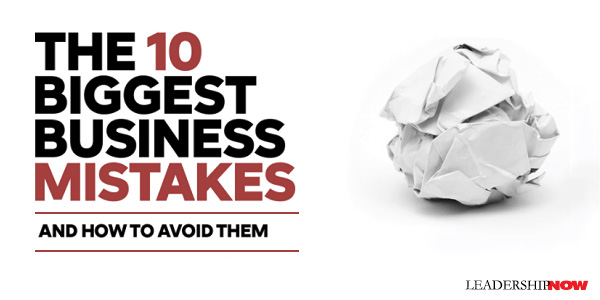
IF YOU CAN LEARN from other’s mistakes, you have a better shot at success. Lawyer, CPA, and serial entrepreneur, Patrick Burke, says he has made most of these big mistakes and has (barely) lived to tell about it. He chronicles them in The 10 Biggest Business Mistakes: And How to Avoid Them. Some of the lessons learned are timing issues. Some seem like common sense, but in the heat of the moment and the hubris that often accompanies entrepreneurship, these lessons are easily forgotten. The uncertainty and the need for resources lead many into mistakes. Slowing down and thinking about these things will increase your odds of success. Here is a brief overview of the wisdom Burke offers: Mistake #1: Buy or Start the Wrong Business It’s not a bad business, it’s just not your business. The most critical element in a business’s success is a sustainable advantage. If you are the sustainable advantage, be careful. “Many is not most small businesses are (or at least start out as) personality cults. There’s nothing wrong with that, but a cult is not sustainable. If you are buying a business, make sure it’s not based on the last personality. “If you’re starting your own business, create processes that allow others to be you so you can successfully scale.” Mistake #2: Lifestyle Lifestyle businesses are not inherently bad. “The problem occurs when a business could be a growth business and should be a growth business but instead is starved for cash because the owner is treating it as an ATM.” A good lifestyle business coupled w2ith smart investing will result in financial security, but not real wealth. Real wealth results from building a growth business with a sustainable advantage that can someday be sold at a high multiple of earnings. Mistake #3: Professionals Hire professionals with the expertise required for what you are trying to do. “There is no reason to continually learn from your own mistakes when you can draft off professionals who can prevent them. You should always be willing to pay for and follow great advice. Paying for advice is a capital investment in a valuable piece of mental machinery.” Mistake #4: Partnering The gold standard for taking on a partner: “A business owner should bring someone in as a partner only if that person possesses a skill that is absolutely critical to the success of the business and that skill cannot be acquired for money alone.” Treat the equity in your business as your most valuable asset. Mistake #5: The Wrong Team Most entrepreneurs hire too fast and fire too slow. “Most entrepreneurs are imbued with a super-strong work ethic and boundless optimism. They truly believe they can transform employees, even those with below-average skills and drive, into valuable players through their excellent example and the sheer force of their iron will. This is patently not true.” Mistake #6: Think Big Johann Wolfgang von Goethe is said to have written, “Dream no small dreams for they have no power to move the hearts of men.” This should inform your business decisions. “If what you’re doing is not leading you to your destination, you may be thinking too small.” Mistake #7: Close Too Soon Develop a good cash forecast prior to opening the business, one that can survive a downturn in the beginning. If you are successful in building a brand, “even though the business is not yet profitable, it should continue. A brand is the ultimate sustainable advantage and should be fully exploited.” Mistake #8: Close Too Late Avid the sunk cost trap. Once you have invested so much time, effort, and money into something, it’s hard to let go. Many entrepreneurs persist beyond the point where the odds of success are in their favor. “The impulse to throw good money after bad to prop up a failing business is extremely common. In my opinion, this impulse has resulted in more business losses than any other factor.” Since sunk costs are irretrievable, it’s nest to act like you have only the present and the future—because you do. With that in mind, it’s easier to detach yourself emotionally from your past decisions. Mistake #9: Sell Too Soon It’s hard to get the price you want when you want to get out. “The idea that the price paid for companies is based on past performance is only partly true. However, the idea buyers will actually pay for tomorrow’s potential is mostly wrong. By far, the most important data to a buyer is current performance and, based on the company’s processes and metrics, how predictive that is of future performance.” And keep this in mind too: “If your company is too early in its life cycle to attract more than one potential buyer, negotiating will be impossible because the only alternative is no deal.” Mistake #10: Sell Too Late Timing is everything. Greed is sometimes the reason owners stay too long; trying to get a few more years of profit. Some “wait until their energy and passion are waning and then take their business to market. At that point, the business is generally in decline if not fully distressed.” I have been advising clients for years not to pay for potential when acquiring a small business. I suggest that a seller’s puffing about new opportunities, products, and services be countered with pointed questions about why those ideas haven’t already been implemented. If your business is a lifestyle business, stick with it as long as possible and then close the doors. 
Posted by Michael McKinney at 07:43 AM
06.10.21

Leading Thoughts for June 10, 2021
IDEAS shared have the power to expand perspectives, change thinking, and move lives. Here are two ideas for the curious mind to engage with: D. Michael Lindsay observed that the best leaders have shown excellent management of the transitional events in their lives: “The challenge with life is that we have to live it moving forward, but we only really understand it looking back. Every day offers the promise of preparing us to best respond to the next hinge moment of our lives. Source: Hinge Moments: Making the Most of Life's Transitions Bruce Feiler on our personal narratives: “Each one of us carries around an unspoken set of assumptions that dictate how we expect our lives to unfold. These expectations come from all corners and influence us more than we admit. We’ve been led to believe that our lives will always ascend, for example, and are shocked to discover they oscillate instead. Our society tells us we should be basking in progress, but our experience tells us we are beset by slip-ups. Might this gap help explain the anxiety so many of us feel?” Source: Life Is in the Transitions: Mastering Change in a Nonlinear Age Look for these ideas every Thursday on the Leading Blog. Find more ideas on the LeadingThoughts index.
Posted by Michael McKinney at 03:19 PM
06.08.21

We’ve Coached Over 1 Million Supervisors … Here’s What We Learned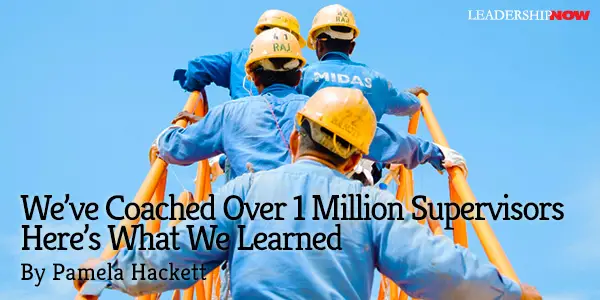
WANT A WORKPLACE with fewer accidents? Want to achieve better results? Perhaps your boss wants to avoid the 75% to 80% failure rate that plagues company transformations. You’ve probably heard the stats: only 25% of business transformations cross the finish line. No matter how big or small the change you want to make, if you’re a team leader, it all comes down to you. That’s a little different than what our guts tell us, right? It’s easy to point the finger at top leadership—it starts with them. The CEO needs to be leading the parade, setting the vision, and pointing the way. Well, yes, she does. But that’s not enough. And then there’s the view that if you properly scope out what needs to change, you’ll get there. After all, aspiration—the “what”—is as important as the “how” when you want to make big change. That’s true, too. But it’s also not enough. While the last decade has flattened our organizations and reduced the need for some managers, the need to create leaders at every level has never been more necessary. Not to supervise but to build great workplaces that work for people, not against them. We need frontline leaders to help workers bring their best selves to work each day, to find out what’s holding team members back and how to address it. We need connected managers to create community and spark collaboration. Essentially, we need these leaders to engage, enable, and energize the people on their teams. And it starts with really understanding the role of the frontline team leader. An Eye-Opening Revelation That’s been one of the most eye-opening revelations for many of the supervisors we’ve worked with over the past few decades. After conducting a few million DILOs (Day in the Life of) across 30,000 organizational operations assessments, we found one thing in common. Those who get out on the floor where the work gets done, who spend time with their teams, who listen and learn about the people and ecosystems that make up their workplace, make better decisions. When supervisors actively engage their team members—getting out of their offices and lifting their noses from their reports and devices—their teams are more productive, often safer, and their businesses are more profitable. Supervisors hold the success of a business in their hands, and it’s all in how they manage. Put simply: those who don’t engage their people don’t do well. So how do you engage well? Here are a few pragmatic solutions to get you started:
When you recognize that nothing moves until your people move, it’s clear that it’s the supervisor’s job—their primary purpose, in fact—to move their people to move. A supervisor’s or manager’s presence is key to results, transformations, and safety in the workplace. If you want to be a great leader, you must first manage to engage.  
 
Posted by Michael McKinney at 03:44 PM
06.04.21

Tim Grover on Winning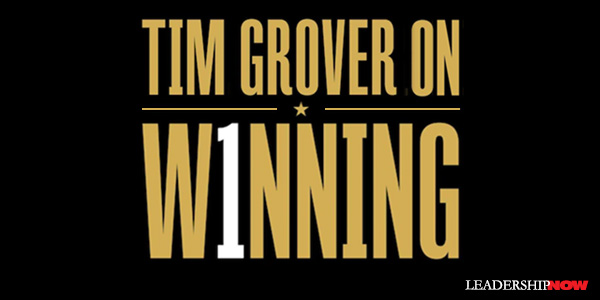
WINNING has its own language and its own code. And motivational talk isn’t part of it. Sports trainer and mindset expert to Michael Jordan, Kobe Bryant, Dwyane Wade, and others, Tim Grover (with Shari Wenk) provides a look at what it takes to perform at the highest levels in any field in Winning: The Unforgiving Race to Greatness. Grover says winning is uncivilized, hard, nasty, unpolished, dirty, rough, unforgiving, unapologetic, uninhibited, and everything. Results are all that matter. “Winning will cost you everything, and reward you with more.” For many of us, the problem is that winning is “trapped under a lifetime of fear and worry and doubt.” There are thirteen—equally important—characteristics of winning presented very candidly by Grover. The Winning Thirteen: WINNING Makes You Different, and Different Scares People Ask questions because if you do what everyone else is doing, you will end up like everyone else. “When you know what to think, you’re ready to compete. When you know how to think, you’re ready to win. Your education teaches you what to think. Life experience teaches you how to think.” I have one nonnegotiable: Performance. Everything contributing to that is open to discussion, as long as we arrive at the same end result. The one thing we’re not going to negotiate is anything that adversely impacts your performance. WINNING Wages War on the Battlefield in Your Mind All day, every day, your mental battlefield is attacked by blasts of adrenaline and anger and fear and anxiety, and other explosives too. Stress. Insecurity. Doubt. Envy. Winners can detect those bombs and defuse them before they can do any damage. Losers brace for impact and wonder how to clean up the mess. You need routines if you are going to win these battles and manage the distractions. The routines allow you to execute without rethinking. For Jordan, his routines allowed him the “mental freedom and clarity to focus on one thing: the complexity of the game, and manage every variable that stood between himself and a win.” WINNING Is the Ultimate Gamble on Yourself For leaders, like athletes, it’s not just the traits but how they are put together, and each person is unique. Winning is about having the confidence to gamble on yourself. Confidence is feeling as low as you’ve ever felt in your life, and knowing you’ll recover stronger than you were before. It’s hearing others tell you everything is fine, you’re perfect just the way you are … and knowing they’re wrong and you still have work to do. WINNING Isn’t Heartless, But You Will Use Your Heart Less Your mind is stronger than feelings. “You have to know when to turn your heart off, and your mind on.” You want energy. Focus. Intensity. You want to be alert and aggressive and strong. None of those are emotions, they are a state of mental power. You want your mind locked in, so you don’t even feel the nerves and the pressure that come with competition. WINNING Belongs to Them, And It’s Your Job to Take It Winning begins with you. “Should I go to the gym? Should I skip this donut? Can I get out of the house on time? Will I get my work done today?” Winning has no loyalty to you. No matter how long you’ve battled to become a winner, it takes one split second to become a loser. I know that’s a hard reality for a lot of people. They work so hard to get somewhere, and in an instant, it’s gone. They gave it up. Or more likely … someone took it. WINNING Wants All of You; There Is No Balance Focus and commitment. That means mastering the art of “NO.” If you give everything in your life equal weight, you are out of the race. Every time you say yes, every time you say maybe or not right now when you really want to say no, Winning rolls its eyes and looks for someone else. WINNING Is Selfish Winners don’t care what you think, they just need results. Selfishness is about separating yourself from the average—“to move from where you are to where you want to be.” But Grover notes, “separation doesn’t mean you cut all ties and refuse to cooperate. Collaboration and cooperation are essential in my business, and probably in yours too.” Selfishness means investing in yourself. Forget secret codes. “Invest in your education and your skills. There are no shortcuts, there’s no fast track.” WINNING Takes You Through Hell. And If You Quit, That’s Where You’ll Stay Winning is not a permanent destination—once on top, always on top. “It’s a never-ending cycle, not a one-way trip. You want to win? Start at the bottom and work your way up. Congrats, you won. You want to feel that way again? Go back to the bottom and work your way up.” Over and over. Resilience isn’t built in your comfort zone; it’s built in hell. And every time you go back you’re a little harder, rougher, less emotional, more scarred. WINNING Is a Test with No Correct Answers Resilience is a daily issue. We all have insecurity and a fear of failure. But Winners don’t let it hold them back. “Don’t allow your fear to escalate into uncontrollable doubt.” Fear shows up on its own. Doubt has to be invited. Fear heightens your awareness; it makes you alert. Doubt paralyzes your thinking. WINNING Knows All Your Secrets You aren’t alone. There are voices inside your head—especially at night when there is less to distract you. WINNING Never Lies You can’t fake winning. “Winning knows the truth. And it needs you to admit it. Because even if you can fool absolutely everyone else … you still know the truth.” If you can’t summon the desire and energy to make I, someone else will. WINNING Is Not a Marathon, It’s a Sprint with No Finish Line Every step is important no matter the distance. You keep going until it gets done. But… When you get to the finish, you should already see the next starting gate in front of you. WINNING Is Everything You have to put in the work now. Our opportunity to win is now. Each and every day, but time is limited. The biggest mistake we make in life is thinking we have time. Grover backs up each point with insights from his clients—especially Michael Jordan and Kobe Bryant. Winning defines the road less taken. 
Posted by Michael McKinney at 03:53 PM
06.03.21

Leading Thoughts for June 3, 2021
IDEAS shared have the power to expand perspectives, change thinking, and move lives. Here are two ideas for the curious mind to engage with: Andrew and Nada Kakabadse and Linda Lee-Davies on knowing when to act as well as being in the right place at the right time: “What makes a leader great in one situation could make them incompetent in another and the increasing pace of change in today’s business environment means then that different qualities will not only be needed at different times but also more quickly and drastically. Perhaps then, it is the ability to provide the appropriate leadership qualities and skills at the appropriate time that s secret to being great. Perhaps, it is the ability to which from the transactional needs of the business to the transformational thinking which links the followers toward the future which is key to successful timing.” Source: Leading for Success: The Seven Sides to Great Leaders Pete Davis on a culture of infinite browsing: “I’ve come to believe that this is the defining characteristic of my generation: keeping our options open. Source: Dedicated: The Case for Commitment in an Age of Infinite Browsing Look for these ideas every Thursday on the Leading Blog. Find more ideas on the LeadingThoughts index.
Posted by Michael McKinney at 08:50 AM
06.02.21

Grace Notes: Leading in an Upside-Down World
IN Grace: A Leaders Guide to a Better Us, John Baldoni laid out a philosophy for better leading and living. Now in Grace Notes: Leading in an Upside-Down World, he reflects on the practical application of that philosophy. Over the course of the last year, he collected his thoughts on the response to the pandemic and its implications. Baldoni is a generous encourager. So, it is no surprise that he shares with us practical positive thoughts. These notes touch on many elements of what it means to be a good citizen, a friend, and a leader. Here are several that stood out for me: KINDNESS
To be thinking of one another
ABUNDANCE
Abundance is rooted in Grace.
All of us have something we can share.
MAKING PERSONAL CHANGE
My philosophy is anchored in the notion of Grace,
GENEROSITY
He shares this mandate for leaders—Leadership Now: STEP TO THE FORE
Offering over 60 notes, Baldoni reflects on many qualities that are central aspects of grace like patience, kindness, and respect. He also writes about anxiety, managing doubt and discouragement, and how to make this our finest hour. You will finish this little book inspired to be a better person. 
Posted by Michael McKinney at 12:00 AM
06.01.21

First Look: Leadership Books for June 2021Here's a look at some of the best leadership books to be released in June 2021. Don't miss out on other great new and future releases not listed here.
When we're moving at 115 MPH, we rarely see the wall coming. But it comes for all of us and when it does, we grasp for lessons, for meaning, for purpose. Each moment (good or bad) and each win or loss, provides us an opportunity to learn, and if we choose to take it, that opportunity can change our lives—and the world—for the better. The human spirit craves connection. Authenticity. Belonging. Touch. Gratitude. Purpose. We need to make our interactions count. Whether it's the death of a friend, loss of a job, a bad break-up, or the isolation of Covid-19, those who manage to be where their feet are will grow, stretch and emerge stronger, smarter, and more prepared as we find peace and gratitude in the pause. In Be Where Your Feet Are, this CEO of the Philadelphia 76ers and New Jersey Devils offers his own story of grief and healing, and shares his most valuable lessons in what keeps him present, grounded, and thriving as a father, husband, coach, mentor, and leader.
Transform your organization with speed and efficiency using this insightful new resource. Incremental improvement is no longer sufficient in helping organizations navigate the complexity, uncertainty and volatility of today’s world. In Change: How Organizations Achieve Hard-to-Imagine Results in Uncertain and Volatile Times, authors John P. Kotter, Vanessa Akhtar, and Gaurav Gupta explore how to create non-linear, dramatic change in your organization. You’ll discover the emerging science of change that teaches us about how to build organizations – from businesses to governments – that change and adapt rapidly.
In his career as an executive at IBM, Cisco, and now as CEO of Anaplan, Frank A. Calderoni discovered that character is just as vital for companies as it is for individuals. In Upstanding: How Company Character Catalyzes Loyalty, Agility, and Hypergrowth, the author explores the powerful link between corporate strategy, company culture, and individual character, and how activating this link is essential to realizing strong company character—and an essential ingredient for organizations to achieve hypergrowth, agility, and loyalty. This innovative resource features real-life examples of how today’s most successful companies are building upstanding character while increasing employee engagement, happiness, and performance.
In Japan it's called the "Ghosn Shock"—the stunning arrest of Carlos Ghosn, the jet-setting CEO who saved Nissan and made it part of a global automotive empire. Ghosn spent two decades building a colossal partnership between Nissan and Renault that looked like a new model for a global business, but the alliance's shiny image fronted an unsteady, tense operation. Culture clashes, infighting among executives and engineers, dueling corporate traditions, and government maneuvering constantly threatened the venture. Expertly reported, Collision Course explores the complex suspicions around what and who was really responsible for Ghosn's ouster. It explains how economics, history, national interests, cultural politics, and hubris collided, crumpling the legacy of arguably the most important foreign businessman ever to set foot in Japan.
For years, companies have been implementing programs that promote social responsibility and improve employee health, both of which benefit the financial bottom line. Now it’s time to focus on positive social interactions and relationships in the workplace. In Work Better Together, two experts from Deloitte explain how working remotely, over-relying on digital communication, and always being “on” is fast-increasing feelings of isolation and burnout―and how a work culture driven by quality relationships can reverse these trends. Work Better Together walks you through the process of implementing change and fueling a much-needed corporate movement towards humanity in the workplace.
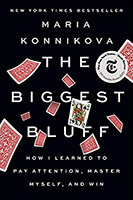  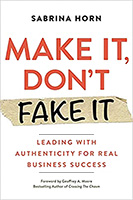
 Build your leadership library with these specials on over 28 titles. All titles are at least 40% off the list price and are available only in limited quantities. “Even when reading is impossible, the presence of books acquired produces such an ecstasy that the buying of more books than one can read is nothing less than the soul reaching towards infinity.” — A. Edward Newton
Posted by Michael McKinney at 08:22 AM
|
BUILD YOUR KNOWLEDGE


How to Do Your Start-Up Right STRAIGHT TALK FOR START-UPS 
Grow Your Leadership Skills NEW AND UPCOMING LEADERSHIP BOOKS 
Leadership Minute BITE-SIZE CONCEPTS YOU CAN CHEW ON 
Classic Leadership Books BOOKS TO READ BEFORE YOU LEAD |
|